NOTES
Saturday, September 29, 2007
Saturday, 8:07 am
crisp, sunny morning
Birds:
mwbw
rrmo
unbanded--left leg especially swollen
unbanded juvenile
plbmp
wwmlb
mlbrg
unbanded with leg mites, especially swollen right back toe
Finally returning to my observations. I'm in the habit of feeding the birds in the afternoon now, the morning comes so quickly on a back-to-school schedule, and my resident pair aren't here yet. Arriving first are mwbw, rrmo and one unbanded bird--clearing the peanuts out, not taking time to crack nuts and eat. Mwbw gives the male cheep cheep cheep call, though it doesn't seem that anyone is around to listen but his mate. She spends much more time shopping for nuts than she did in July. She appears more confident. Rather than perching skittishly on a limb, and swooping in quickly for a peanut, she selects first one, then another, until she finds just the right peanut.
The pair is joined by plbmp and Shopper (mwbw), mlbrg, and some unbanded birds with leg mites. As usual I'm mystified trying to distinguish whether or not mlbrg has a partner.
At 9:00, there is still no sign of the resident pair.
crisp, sunny morning
Birds:
mwbw
rrmo
unbanded--left leg especially swollen
unbanded juvenile
plbmp
wwmlb
mlbrg
unbanded with leg mites, especially swollen right back toe
Finally returning to my observations. I'm in the habit of feeding the birds in the afternoon now, the morning comes so quickly on a back-to-school schedule, and my resident pair aren't here yet. Arriving first are mwbw, rrmo and one unbanded bird--clearing the peanuts out, not taking time to crack nuts and eat. Mwbw gives the male cheep cheep cheep call, though it doesn't seem that anyone is around to listen but his mate. She spends much more time shopping for nuts than she did in July. She appears more confident. Rather than perching skittishly on a limb, and swooping in quickly for a peanut, she selects first one, then another, until she finds just the right peanut.
The pair is joined by plbmp and Shopper (mwbw), mlbrg, and some unbanded birds with leg mites. As usual I'm mystified trying to distinguish whether or not mlbrg has a partner.
At 9:00, there is still no sign of the resident pair.
Subscribe to:
Post Comments (Atom)
Pia Sets the Trap

07/24/07
Peaking...

07/24/07
Oops, wrong bird!

Demonstrating the "hold"
Try Again

Bird in the Bag
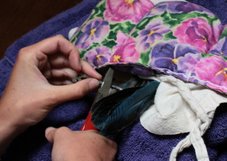
Applying a metal band
Measuring
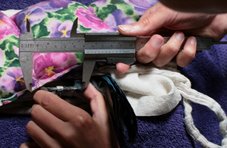
and more measuring. . . .
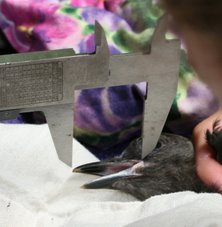
Blood Sampling

Jeff J's Work

Pia's test tube holder
Weighing
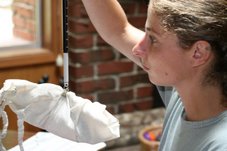
And then....release
When the sun goes down...

Steller's Jay Taxonomy/Description
Common Name: Steller's Jay
Class: Aves
Order: Passeriformes
Family: Corvidae
Genus: Cyanocitta
Species: Cyanocitta stelleri
Steller’s jay belongs to the family, Corvidae, in the Avian Order Passeriformes. Passeriformes is the order of perching birds. Corvidae is the jay, magpie and crow family. The Steller's jay's scientific name is Cyanocitta stelleri. The generic name, cyanocitta, means "blue jay". Its specific name, stelleri, named for George W. Steller (1709-1746). Steller was a German zoologist who explored the coastal areas of the northern Pacific Ocean in 1740.
Band Colors
black | white | purple | red | orangeBands are read in the following order:
light blue and light blue | green
Note: Light blue is difficult to read. It darkens with age, resembling a green band. (b/w/p/r/o/lb/g)
right bottom band
right top band
left bottom band
left top band
Data Collecting
This information was copied from the website of Dr. Jeff Black, Humboldt State University Wildlife Department.
The data to include for each record:
- Bird’s color code
- Size of social group seen at the same time
- Associates’ color codes (or if unbanded = UNB; or not determined = NOTD)
- Number of times associates came within 3 meters of each other
- Approximate time spent within 3 meter distance (e.g. 2 seconds, 15 sec, etc.)
- Total time you watched the birds (e.g. 5 minutes, 10 min, etc.)
- Time of day; start of observation (e.g. 1935)
- Date (e.g. 9.30.99)
- Location of observation (e.g. Rewood Bowl SW corner west bleachers. And state whether the bird was seen at a birdfeeder or in trees, etc)
- Comments (e.g. deformed leg, feather tuft on back, etc.)
Arcata Steller's Jay Sightings
Mr. Go










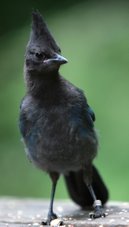










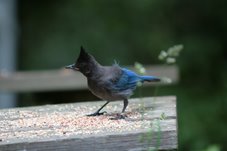











No comments:
Post a Comment